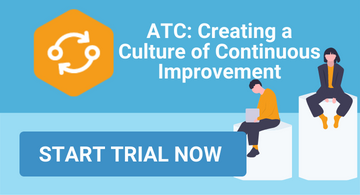Having spent time setting up your Continuous Improvement Roadmap, it must do its job and help you through the implementation of your long-term objective or project. As with so many things in life, just setting it up is not enough, it is important to share it with everyone else working on the objective/project and to use it to best support you and the whole team.
In my article, How to Build a Continuous Improvement Roadmap: a Practical Guide I explore in detail how to set up a Continuous Improvement Roadmap using the ATC Platform.
I am now going to delve into how to ensure that Continuous Improvement Roadmap delivers the maximum benefit.
Invite Users
Inviting users is an absolutely key step – the value of your Continuous Improvement Roadmap will be limited if you are the only person using it.
.png?width=433&name=Untitled%20design%20(13).png)
This applies even if you are the only person actually delivering on the project - you still need to share it with your customer(s) and everyone else effected by the project.
By sharing your Continuous Improvement Roadmap you can:
- Ask users to contribute improvement ideas
- Ask users to comment and vote on the ideas already in the Continuous Improvement Roadmap - this can help you prioritise the order in which roadmap ideas should be implemented
- Assign actions to the person responsible for completing them
- Keep everyone informed about the whole plan – they can look at the most up-to-date version at any time
To invite Users to share and contribute to your ATC Free Continuous Improvement Roadmap, go to Dashboard>Invite Users. Enter their e-mail address into the ‘Email field’ and ATC will send them an invitation to join your Crowd.
Security
You can also share the invitation link URL, anyone clicking on it can join your Crowd. However, when you invite Users to share your Continuous Improvement Roadmap, you will probably want to make it by invitation only, so you know exactly who has access.
This makes managing content/Input security very easy, if you only invite Users involved with your project to join your Crowd, you can share all ideas/content with all ‘Users (Everyone)’.
If, however you want to restrict the access to certain ideas/inputs to a sub-section of Users, you can set up additional groups of users by going to Dashboard>Roles & Users and clicking, ‘+Add New Role’.
Setting up a new Role, also allows you to give Users with that Role, permissions to use specific ATC features. This will enable you (the Crowd Owner) to share responsibility for managing the Continuous Improvement Roadmap should you want to.
Having typed the Role Name in the Role Name field, click ‘Add’.
To assign Users to that Role, click the ‘Edit’ button next to the new Role:
and then click on the ‘+Add User To Role’ button.
In the next screen, as you start to type in the ‘User’ field, the names of your Users will show in the drop down.
Select each one that you want to be in this security group and click ‘Add’.
Managing Continuous Improvement Ideas/Inputs
As previously mentioned, a core benefit of sharing your Continuous Improvement Roadmap is that Users can submit their own ideas directly into the Roadmap. They do this in exactly the same way you - the Owner - do, by going to Inputs in the main menu and clicking '+ Provide Input'. A ‘Give Input’ box pops up, where they type their idea, completing both the 'Title' and 'Description' fields and clicking 'Send Input'.
All the ideas and suggestions which they input will be flagged up in your ATC Crowd Dashboard for you to moderate:
At this point the Input is only visible to you and the Author.
If you feel the idea is totally inappropriate or not at all useful, you can delete it, by clicking ‘Delete Input’. You will be asked to input the reason why. Do be aware that whatever you type here will be e-mailed to the Author.
Otherwise, you can edit the title and the Input detail if this is needed.
Then you should either:
- Add it to your Continuous Improvement Roadmap by allocating it to the relevant Topic (in my case ‘Website’), updating the Lifecycle to ‘Continuous Improvement’ and setting the relevant Input Security (don’t forget to click Save Changes for this one).
or
- Set up a new Topic more suited to this particular idea and allocate it to that. You will want to do this when the idea is a good one and you want to retain it, but not relevant to the objective or project that your Continuous Improvement Roadmap relates to.
Prioritising Ideas
A key element of managing a Continuous Improvement project is prioritising improvement ideas. You will of course need to take many factors into consideration when doing this – such as budget and resources available – but a key factor is how much support an idea has.
ATC really helps with this as it enables Users to comment and vote on the ideas captured in your Continuous Improvement Roadmap. All they need to do is Click on ‘Inputs’ in the main menu and then they will be able to vote ideas up or down…
and add their comments.
You will receive an e-mail alerting you to this each time.
Users are automatically Subscribed to an Input when they vote or comment on it. They can also subscribe by clicking the bell shape on any Input. Being subscribed means Users are e-mailed when anything relating to the input is changed or updated.
You can then filter all the ideas/Inputs in the Roadmap to see which ones are most popular.
Keeping Track
While perhaps meeting with the rest of your team to review the Continuous Improvement Roadmap – the multiple filtering options really help with this – you decide which of the activities/Inputs that you are going to action first and record this by updating their Lifecycle Stage to ‘Agreed to Action’.
And the Release Stage to ‘Priority 1- Must Have’.
Assigning Actions
Another key element of a Continuous Improvement Roadmap is keeping track of who is responsible for delivering on the Inputs that you have agreed to action. Inputs can be assigned to any User who has joined your Crowd. The Input’s Owner remains unchanged (as you) unless you specifically change it. (There is a charge for the second and each subsequent owner of each Crowd.)
Once the assignee has completed the activity as set out in the Input, they can update the Stage and reassign it as appropriate.
As any Input is completed again the stage will be updated to ‘Completed/Signed Off’ and the Release updated to the relevant month. This means that you will later be able to filter Release on say ‘October 2020’ and see all the Inputs completed in that month.
Full Transparency & Reporting
So not only are you keeping track on exactly what’s planned to be done, by whom and when, but your whole team is being kept updated at all times too.
You can also use the Filtering to very effectively support reporting and planning meetings.
ATC
Of course, no Continuous Improvement Roadmap replaces the need for meetings and excellent team communication – but one set up in ATC Free will best support those meetings and that communication, best enabling you and your whole team to work together to deliver on your chosen long-term objective.
Sign up to the ATC Platform and get started!
You will soon work out what Topics, Lifecycle Stages and Releases etc will best support your project, but to get started follow the approach set out in my article How to Build a Continuous Improvement Roadmap: a Practical Guide and then edit them later.
Related Articles:
How to Build a Continuous Improvement Roadmap: a Practical Guide
The Complete Guide to Continuous Improvement in Business
What is Continuous Improvement? A Simple Guide
Related White Papers:
Written by Emma Harris
Emma was Operations Director for Triaster for nearly 20 years, during which time as well as learning and perfecting her BPM and process improvement skills, she honed her inbound marketing expertise. She now runs D2e - Designed to engage - which designs and develops bespoke, engaging, HubSpot CMS websites, that help your entire company to grow and scale. She is delighted to still be delivering Triaster's marketing, whilst also helping other companies turn their websites into their hardest working asset.



